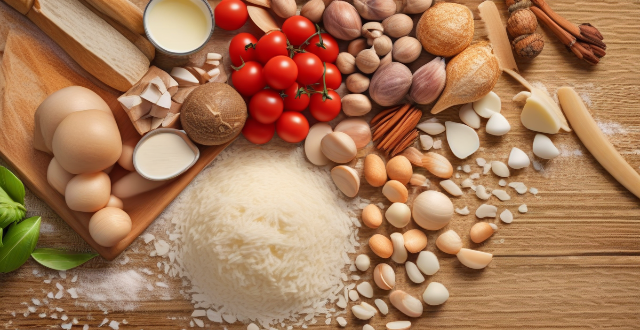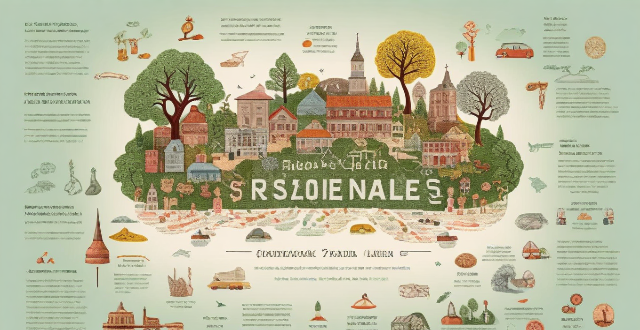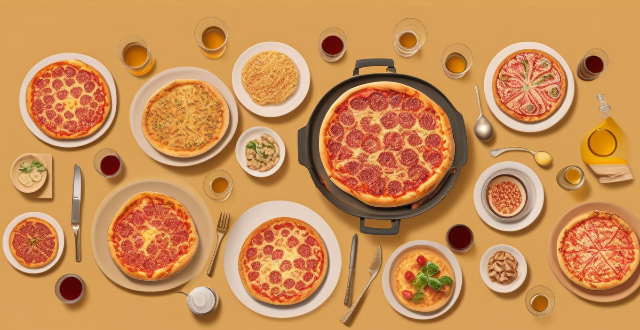Cuisine Fusion

In what ways does cultural fusion influence food and cuisine around the globe ?
Cultural fusion significantly impacts global cuisine by introducing diverse ingredients, techniques, and fusion cuisines. It encourages culinary innovation and creativity while also promoting the globalization of food cultures. Additionally, cultural fusion affects eating habits and dietary restrictions worldwide.

How has Indian cuisine evolved over time ?
The evolution of Indian cuisine is a result of various factors such as geography, climate, history, culture, and trade. India's diverse geography and climate have led to unique culinary traditions in each region, with coastal areas known for seafood dishes and northern plains famous for dairy products and bread. Historical influences like the Mughal era and British colonial period have also shaped Indian cuisine, introducing fusion dishes and bakeries. Trade routes and globalization have integrated foreign flavors into Indian dishes, while regional variations highlight the country's culinary diversity. Modern innovations include fusion dishes and healthier versions of traditional recipes. Overall, Indian cuisine reflects the nation's rich cultural diversity and adaptability to changing trends.

Can you provide examples of cultural fusion in different parts of the world ?
Cultural fusion, also known as cultural integration or hybridity, is a phenomenon that occurs when two or more distinct cultures interact and blend to create a new, unique culture. This process can be observed in various parts of the world, where different cultures have come together to form new traditions, languages, cuisines, art forms, and lifestyles. Some examples of cultural fusion include Korea-Japan cultural exchange, India-Pakistan cultural influence, Spain-Morocco cross-cultural interaction, France-England historical interactions, Mexico-United States border culture, and Caribbean-African diasporic cultures. These examples illustrate how cultural fusion can lead to the creation of new and exciting forms of expression across different aspects of society.

How has technology impacted the process of cultural fusion ?
Technology has revolutionized the way we live, work, and communicate, significantly impacting cultural fusion. It has increased accessibility to different cultures through the internet, social media platforms, and messaging apps, leading to a greater exchange of ideas, beliefs, and practices between cultures. Online courses have made education more accessible than ever before, promoting understanding and appreciation of diverse cultures. Travel and tourism have been enhanced by technology through virtual tourism and navigation apps, allowing for greater engagement with local cultures during trips. Food blogging and social media platforms have played a significant role in promoting cultural fusion through cuisine, while online grocery shopping has facilitated the creation of authentic dishes from various parts of the world. Overall, technology has facilitated the exchange of ideas, beliefs, and practices between cultures, leading to greater levels of cultural integration in the future.

Can cultural fusion lead to a loss of cultural identity ?
Cultural fusion, the blending of different cultures, has been a phenomenon for centuries. However, with globalization and the rise of social media, cultural fusion has become more prevalent than ever before. While it can lead to the creation of new and exciting cultural expressions, it can also raise concerns about the potential loss of cultural identity. This article explores whether cultural fusion can indeed lead to a loss of cultural identity by examining the benefits of cultural fusion, the potential loss of cultural identity, and ways to maintain cultural identity amidst fusion.

What are the benefits and drawbacks of cultural fusion in education systems ?
Cultural fusion in education systems can enhance global awareness and improve intercultural communication, but it may also lead to a loss of cultural identity and stereotyping. To maximize its benefits, cultural fusion should be implemented thoughtfully and effectively.

What is cultural fusion and why is it important ?
The text discusses cultural fusion, which is the blending of different cultural elements from various backgrounds. This process involves exchange, adaptation, and integration of traditions, customs, languages, cuisines, arts, etc. Cultural fusion is important because it promotes diversity and inclusivity, drives innovation and creativity, facilitates global understanding and peace, enhances economic opportunities, and supports sustainable development. It is essential for promoting harmony, innovation, and sustainability in an increasingly interconnected world.

Why is French cuisine, including desserts, considered among the finest in the world ?
French cuisine, including desserts, is renowned worldwide for its exquisite flavors, meticulous preparation, and artistic presentation. This reputation is due to factors such as historical significance, quality ingredients, artisanal methods, chef training, innovation, and attention to detail. French cuisine has a long history dating back to medieval times when it was influenced by various cultural invasions and trades. Over centuries, French chefs refined their techniques, creating a rich culinary tradition that emphasizes depth of flavor and precision in cooking methods. French cuisine places a high value on using fresh, high-quality ingredients, often sourced locally. The variety of ingredients available in different regions of France allows for a wide array of dishes and flavors. French baking traditions, such as those used in making croissants and baguettes, involve complex processes that yield exceptional results. Many French desserts, like macarons and éclairs, are handcrafted with care, ensuring each piece is of the highest quality. France is home to some of the best culinary schools in the world, where future chefs receive rigorous training. Young chefs often learn from experienced masters through apprenticeships, preserving techniques and recipes. French chefs are known for their innovative approaches to traditional dishes, pushing the boundaries of gastronomy. The integration of international flavors into classic French dishes keeps the cuisine dynamic and exciting. French cuisine emphasizes not just taste but also the visual appeal of the dish, making every meal an experience. The emphasis on all senses—smell, sight, taste, touch, and even sound—creates a comprehensive dining experience.

How does cultural fusion affect society's development ?
Cultural fusion is the process whereby different cultures influence each other over time. This phenomenon can have a significant impact on society's development in various ways. In this article, we will explore how cultural fusion affects society's development and discuss some examples of its effects. One of the most obvious benefits of cultural fusion is that it enhances diversity within a society. When different cultures come together, they bring with them unique perspectives, traditions, and values that can enrich the overall culture. This can lead to increased creativity, innovation, and social progress. Another benefit of cultural fusion is that it promotes tolerance and understanding among people from different backgrounds. By learning about and experiencing other cultures, individuals become more open-minded and accepting of differences. This can help to reduce prejudice, discrimination, and conflict within society. Cultural fusion also plays a crucial role in facilitating globalization. As cultures interact and exchange ideas, goods, and services, they become more interconnected and interdependent. This can lead to increased economic growth, trade opportunities, and international cooperation. While cultural fusion can bring many benefits to society, it also presents some challenges that must be addressed. These include loss of cultural identity, erosion of cultural heritage, and cultural imperialism. There are many examples of cultural fusion throughout history and around the world today. Some notable examples include food culture, music culture, and fashion culture.

What is the relationship between cultural fusion and social acceptance ?
The text discusses the interplay between cultural fusion and social acceptance, two significant phenomena that shape modern societies. Cultural fusion is defined as the process where different cultures interact, leading to new cultural forms, while social acceptance refers to the degree of support for diversity within a society. The text outlines key points for each concept: diversity, innovation, and interconnectedness for cultural fusion; tolerance, empathy, and equality for social acceptance. It then explores their interaction, suggesting that cultural fusion can promote social acceptance by increasing exposure to different cultures, breaking down stereotypes, and promoting tolerance. Conversely, high levels of social acceptance can foster further cultural exchange and innovation. The conclusion emphasizes the cyclical relationship between the two concepts and their importance in building harmonious societies that embrace diversity and change.

What role does cultural fusion play in globalization ?
Cultural fusion plays a significant role in globalization by enhancing cross-cultural understanding, promoting innovation and creativity, facilitating economic growth, and enhancing tourism experiences. It refers to the blending of different cultures, traditions, and practices from various parts of the world. This process has become increasingly important as globalization continues to bring people closer together through trade, travel, and communication technologies.

Are there any celebrity-owned or frequented high-end restaurants I should try ?
If you're looking for a high-end dining experience with a celebrity touch, several restaurants owned by or frequented by celebrities are worth trying. Here are some of the top options: 1\. **Nobu Malibu**: Located in Malibu, California, and owned by Robert De Niro, Nobu Malibu offers stunning views of the Pacific Ocean and signature dishes like Black Cod with Miso and Yellowtail Sashimi with Jalapeño. 2\. **Giorgio Baldi**: Known for its romantic atmosphere and delicious Italian cuisine, Giorgio Baldi in Santa Monica, California, is formerly owned by George Clooney. Must-try dishes include the Lobster Ravioli and the Branzino al Salmoriglio. 3\. **The Polo Lounge**: The Polo Lounge at the Beverly Hills Hotel is a classic Hollywood haunt where you can enjoy traditional American fare while keeping an eye out for A-listers. Don't miss the signature McCarthy Salad and the Prime Rib. 4\. **Mr. Chow**: Mr. Chow is a legendary Chinese restaurant chain that has been a favorite among celebrities for decades. The menu features upscale Chinese cuisine, including Peking Duck and XO King Prawns. 5\. **TAO Downtown**: TAO Downtown is a vibrant nightlife destination that also serves upscale Asian fusion cuisine. The menu includes sushi, dim sum, and larger plates like Whole Lobster with Truffle Ginger Sauce. 6\. **Madeo**: Madeo is a chic Italian restaurant that attracts a celebrity crowd with its modern Italian cuisine and trendy atmosphere. Dishes like the Cacio e Pepe and the Branzino Al Forno are standouts on the menu. 7\. **Catch LA**: Catch LA is a seafood restaurant and rooftop bar that has become a celebrity magnet thanks to its delicious food and lively atmosphere. Must-try dishes include the Yellowtail Snapper Crudo and the Lobster Newburg. 8\. **Spago Beverly Hills**: Owned by celebrity chef Wolfgang Puck, Spago Beverly Hills is known for its innovative Californian cuisine. The menu features seasonal dishes like Roasted Chicken with Morel Mushrooms and Artichokes Barigoule. 9\. **Chiltern Firehouse**: Chiltern Firehouse is a members-only club that has become a favorite among celebrities like Emma Watson and Kate Moss. The menu features upscale British cuisine, including dishes like Beef Wellington and Fish and Chips. 10\. **The Ivy**: The Ivy in Los Angeles is a legendary spot for celebrity sightings and power lunches. The menu offers classic American fare like Crab Cakes and Grilled NY Steak.

What is the current state of fusion power research and its potential as an ultimate renewable energy source ?
Fusion power research aims to harness energy from fusing atomic nuclei, similar to the sun's process. Key developments include the ITER project, breakthroughs in magnetic confinement fusion, and advances in inertial confinement fusion. Challenges include technical hurdles, economic viability, and safety concerns. Fusion power has potential as an ultimate renewable energy source due to its unlimited and clean energy production, minimal environmental impact, and long-term sustainability.

Where can I find a fine dining experience in Tokyo, Japan ?
Tokyo is famous for its diverse culinary scene, offering a wide range of fine dining experiences that cater to various tastes and preferences. Whether you're in the mood for traditional Japanese cuisine or international fare, there are plenty of options to choose from. Here are some of the top places to find a fine dining experience in Tokyo: ## Traditional Japanese Cuisine ### Kohju - **Location**: Ginza district - **Cuisine**: Kaiseki (traditional multi-course meal) - **Highlights**: Elegant atmosphere, seasonal ingredients, skilled chefs - **Price Range**: High-end ### Ishikawa - **Location**: Shibuya district - **Cuisine**: Sushi (raw fish served with vinegared rice) - **Highlights**: Fresh seafood, expert sushi craftsmanship, intimate setting - **Price Range**: Moderate to high-end ## International Cuisine ### Quintessence - **Location**: Shiodome district - **Cuisine**: French - **Highlights**: Innovative dishes, impeccable service, stunning views of Tokyo Bay - **Price Range**: High-end ### Narisawa - **Location**: Minami Aoyama district - **Cuisine**: Modernist Japanese with international influences - **Highlights**: Creative presentations, locally sourced ingredients, artistic plating - **Price Range**: High-end ## Vegetarian/Vegan Options ### Yohji - **Location**: Harajuku district - **Cuisine**: Vegan Japanese fusion - **Highlights**: Flavorful plant-based dishes, unique flavor combinations, cozy atmosphere - **Price Range**: Moderate ### Sougo - **Location**: Roppongi district - **Cuisine**: Vegan Italian - **Highlights**: Hearty pastas, authentic Italian flavors, friendly staff - **Price Range**: Moderate to high-end ## Budget-Friendly Options ### Ichiran Ramen - **Location**: Multiple locations throughout Tokyo - **Cuisine**: Ramen (noodle soup) - **Highlights**: Customizable broth and toppings, fast service, affordable prices - **Price Range**: Affordable ### Tenya - **Location**: Multiple locations throughout Tokyo - **Cuisine**: Tendon (tempura over rice) - **Highlights**: Crispy tempura, generous portions, quick meals on the go - **Price Range**: Affordable No matter your budget or dietary preferences, Tokyo offers a diverse array of fine dining experiences that will leave you satisfied and eager to return for more.

How can cultural fusion contribute to breaking down stereotypes and promoting diversity ?
Cultural fusion can significantly contribute to breaking down stereotypes and promoting diversity by enhancing mutual understanding, celebrating differences, challenging preconceived notions, encouraging creativity, fostering global citizenship, and providing educational opportunities that support inclusivity and empathy.

Can you suggest any upscale restaurants with stunning views in Sydney, Australia ?
Sydney, the cosmopolitan capital of New South Wales, boasts numerous upscale restaurants that offer breathtaking views. Some suggestions include Quay, situated overlooking the iconic Sydney Harbour Bridge and Opera House, serving modern Australian cuisine in a formal and luxurious atmosphere; Aria, located in the stylish Barangaroo neighborhood, offering innovative Australian cuisine with sweeping views of the harbor bridge and city skyline; The Langham, situated on the top floor of the historic Langham Hotel, providing panoramic views of the city and Botanical Gardens while serving French-inspired fine dining; Tetsuya's, set in a converted warehouse in Woolloomooloo, offering Japanese-Australian fusion cuisine overlooking the beautiful Finger Wharf; and Sepia, located on Level 3 of the Sydney Tower, providing spectacular views of the city and harbour while serving modern Australian cuisine with a focus on wood-fired cooking. These establishments not only offer exquisite cuisine but also provide stunning views of Sydney's iconic landmarks and picturesque skyline, making them perfect for celebrating special occasions or enjoying a memorable dining experience.

How does Chinese cuisine differ from other Asian cuisines ?
Chinese cuisine is one of the most diverse and influential cuisines in the world, with a history that spans thousands of years. While there are many similarities between Chinese cuisine and other Asian cuisines, there are also several key differences that set it apart. These differences include the use of ingredients, cooking techniques, flavor profiles, and regional variations within each cuisine. Chinese cuisine often uses a wider variety of ingredients than other Asian cuisines, including both meat and vegetables. Additionally, Chinese cuisine often incorporates more spices and herbs into its dishes than other Asian cuisines. Another difference is the cooking techniques used. Chinese cuisine often involves stir-frying or steaming foods, while other Asian cuisines may rely more heavily on grilling or baking. Chinese cuisine also tends to use woks for cooking, which allows for high heat and quick cooking times. In terms of flavor profiles, Chinese cuisine has a distinct flavor profile that sets it apart from other Asian cuisines. Chinese cuisine often features bold flavors such as garlic, ginger, soy sauce, and chili peppers. In contrast, Japanese cuisine may have a lighter, more delicate flavor profile that emphasizes umami (savory) flavors. Thai cuisine, on the other hand, may be spicier and more aromatic than Chinese cuisine. Finally, another difference between Chinese cuisine and other Asian cuisines is the regional variations within each cuisine. China has a vast geographic area with many different regions, each with its own unique culinary traditions. Similarly, Japanese cuisine can vary greatly depending on whether it comes from the northern or southern regions of Japan.

What challenges does cultural fusion present in terms of preserving traditional cultures ?
This essay discusses the challenges of cultural fusion in preserving traditional cultures, including loss of authenticity, erosion of cultural identity, commodification of culture, and resistance to change. It emphasizes the need for a nuanced approach that values both preservation and exchange.

How can cultural fusion be promoted within multicultural communities ?
Promoting Cultural Fusion in Multicultural Communities emphasizes the importance of understanding and valuing diversity, fostering dialogue and exchange, promoting inclusion and equity, supporting cultural preservation and innovation, implementing policies and practices, and building partnerships and collaborations. These strategies aim to create a community where diverse cultures are celebrated and respected, leading to a richer and more innovative community life.

What are the most popular pasta shapes used in Italian cuisine ?
The article discusses the most popular pasta shapes in Italian cuisine, highlighting their unique characteristics and ideal pairings. The list includes iconic shapes like spaghetti and linguine, as well as more distinctive forms like fusilli and orecchiette. The popularity of each shape often depends on the region and local traditions, with some shapes being better suited for light sauces and others for heartier dishes. Overall, the article emphasizes the diversity and versatility of pasta in Italian cuisine.

What kind of ingredients are commonly used in Japanese cuisine ?
Japanese cuisine is known for its unique flavors, fresh ingredients, and beautiful presentation. The most commonly used ingredients in Japanese cooking include white rice, brown rice, sweet rice, tuna, salmon, squid, shellfish, chicken, beef, pork, cabbage, eggplant, green onions, mushrooms, soy sauce, miso, udon noodles, soba noodles, ramen noodles, rice vinegar, sesame oil, nori, wasabi, and pickled ginger. These ingredients combine to create the diverse and delicious flavors that make Japanese cuisine so beloved around the world.

How do you describe the taste of authentic Mexican cuisine ?
Mexican cuisine is a vibrant and complex blend of flavors that can be both bold and subtle. Here are some key characteristics that describe the taste of authentic Mexican food: ### Spicy Heat Chili peppers and spices like cumin, oregano, and cinnamon add depth of flavor to many dishes. ### Acidity and Tanginess Lime juice and tomatoes provide refreshing acidity and tanginess, while also contributing sweetness. ### Earthy and Nutty Flavors Beans, corn, and nuts offer earthy undertones and richness to Mexican cooking. ### Sweetness and Fruitiness Fruits such as pineapple and mango, as well as vegetables like sweet potatoes, bring a touch of sweetness to savory dishes. ### Umami Richness Cheese and slow-cooked meats contribute deep, savory flavors to Mexican cuisine. ### Herbaceous Notes Cilantro and epazote provide distinctive, fresh flavors that are essential in traditional cooking. ### Texture Variety Crunchy vegetables and creamy avocado-based sauces offer a range of textures that balance spicier elements. ### Bold and Aromatic Garnishes Onions and cilantro are often used as garnishes, adding sharpness and freshness to dishes. Overall, authentic Mexican cuisine is a harmonious combination of spicy, tangy, sweet, umami, herbaceous, and textural elements that create a complex and satisfying gustatory experience.

What are the best ways to explore the diverse cuisine of South America ?
South America is a continent rich in cultural diversity, and this diversity is reflected in its cuisine. Here are some of the best ways to explore the diverse cuisine of South America: 1. Visit local markets and street food stalls for authentic dishes. 2. Take cooking classes to learn how to make traditional dishes. 3. Dine at local restaurants for regional specialties. 4. Attend food festivals for a variety of South American dishes. 5. Travel off the beaten path for unique culinary traditions. 6. Try different cuisines within South America for a well-rounded understanding of the continent's culinary diversity.

Is there a risk that cultural fusion could result in cultural homogenization ?
The text discusses the risk of cultural homogenization that comes with cultural fusion, which is the blending of different cultures. This process leads to the loss of distinctive features of individual cultures as they become increasingly similar due to globalization, migration, and other forms of cultural interaction. The phenomenon of cultural homogenization is characterized by the loss of heritage, dominance of global culture, and erosion of local practices. Several factors contribute to this, including globalization, mass media, migration, and economic influence. To mitigate the risk, it is essential to promote cultural preservation and exchange while discouraging the domination of any single culture. This can be achieved through supporting local cultures, cultural exchange programs, education, and policy measures.

What are the best places to celebrate a milestone event with fine dining in Chicago ?
Chicago offers diverse fine dining options for celebrating milestone events, from innovative modernist cuisine at Alinea to traditional deep-dish pizza at Giordano's. Other notable places include Boka for a contemporary New American menu and The Publican for farm-to-table dishes. For French cuisine, Tru provides an elegant setting, while RPM Italian offers classic Italian in a sleek environment. Oriole and Smyth + The Loyalist offer unique experiences focusing on seasonal ingredients and boutique beef, respectively. These top spots ensure memorable celebrations for any special occasion.

How do music genres like hip-hop demonstrate cultural fusion ?
This text is a topic summary of the original text. The full text is not available in this context.

How does cultural fusion manifest itself in contemporary art and literature ?
In full: Arts figures backing EU Remain campaign Art figures backing the EU Remain campaign include Sir Peter Bazalgette, Dan Snow, Dame Helen Mirren and Prunella Scales.
![What are the most unique restaurants to visit in [insert city/country] ?](/images/2kge/1396c52e-b7de-4ce6-ad00-9fc11c58b95e.png)
What are the most unique restaurants to visit in [insert city/country] ?
This text provides a guide to the most unique restaurants to visit in a given city or country. It outlines the concepts, highlights, and atmospheres of various restaurants, including themed dining experiences, fusion flavors, and sustainable cuisine options. The goal is to offer readers a diverse range of culinary adventures that cater to different tastes and preferences, encouraging them to explore these unique establishments for memorable dining experiences.

How can I find authentic local cuisine when traveling ?
The text provides a comprehensive guide on how to find authentic local cuisine when traveling. It suggests researching before the trip, asking locals, exploring markets, dining with locals, trying regional specialties, taking cooking classes, using technology, and being adventurous. The guide emphasizes the importance of stepping out of one's comfort zone to enjoy new flavors and dishes.

How does street food influence local cuisine and culture ?
Street food is a crucial element of local cuisine and culture, offering accessibility, diversity, economic benefits, cultural preservation, social interaction, and global influence. It supports local agriculture, encourages innovation, fosters community bonding, and attracts tourism, thereby shaping the culinary scene and cultural identity of a city.